Archived news
< Return to the recent news
Excavation campaign 2022
Published on : 26.05.2023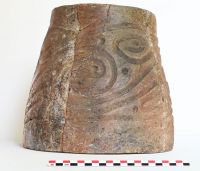
Stand with grooved decoration (Late Neolithic II)A new six-week campaign took place at Dikili Tash in July-August 2022. Research focused on sector 9, on the northern slope of the tell, aiming to bring to light a complete Neolithic sequence from the second half of the 7th to the end of the 5th millennium (Early to Late Neolithic). 35 people, archaeologists, students and workers, from France, Greece and Bulgaria, took part in the operations.
The levels explored in 2022 are still later than 4800 BC (start of the Late Neolithic II). They are covered or disturbed by more recent episodes dating from the Bronze Age (4th-2nd millennium BC). Inside one of the Late Neolithic II dwellings was found the almost complete skeleton of a foetus, aged 25-26 weeks, placed on the floor and covered with pieces of building clay. It is a unique discovery for Dikili Tash, where no burial was found until now, and very rare for prehistoric Aegean and the Balkans in general.
Preliminary reports will soon be published, following those of 2021, in the Bulletin Archéologique des Écoles françaises à l’étranger, the Ergon and the Praktika of the Archaeological Society of Athens. A short presentation on this campaign was made in March 2023 at the Annual meeting on archaeological activities in Macedonia and Thrace.
See the page : Archaeology in Greece Online
Publication of the volume Dikili Tash II,2. History of a tell: the 1986-2016 research
Published on : 16.11.2021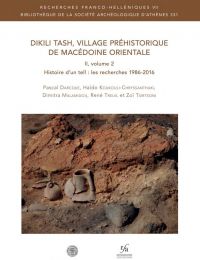
The volume (728 p.) presenting in a synthetic manner the remains discovered and studied at Dikili Tash during the 2nd and 3rd research programs (see archived news of 27.05.2020) came out in Summer 2021. This is a joint edition of the French School at Athens (Recherches Franco-Helléniques, n° VII) and the Archaeological Society at Athens (Library of the Archaeological Society at Athens, n° 331), further funded by the Institute for Aegean Prehistory (INSTAP) and the company RAYCAP (Greek branch). The main text is in French, with extensive summaries in Greek and in English. Printed books are already available, whereas an electronic edition should also be available soon.
See the page : Publications' catalogue
Reprinting of the volume Dikili Tash II,1. Greek-French research 1986-2001
Published on : 16.11.2021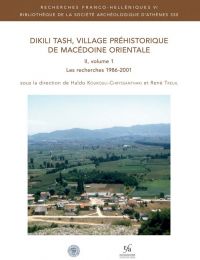
In the frame of their joint editorial policy concerning Dikili Tash, the two institutions under whose auspices are conducted the successive research programs have decided to reprint the volume Dikili Tash, village préhistorique de Macédoine orientale. Recherches franco-helléniques 1986-2001, first published in 2008 as n° 254 in the Library of the Archaeological Society at Athens series. The book, in its new form, is found under the n° 330 of the same series and under the n° VI of the series of the French School at Athens Recherches Franco-Helléniques. It should be reminded that this volume (416 p.) mainly contains Laurent Lespez’s study on the landscape evolution and the history of human settlement in the Philippi-Drama plain (see Abstract), as well as the archaeological maps of the area. It is also here that Haido Koukouli-Chryssanthaki and René Treuil outlined the research axes of the 2nd program, in the frame of which were carried this research.
See the page : Publications' catalogue
Excavation campaign 2021
Published on : 16.11.2021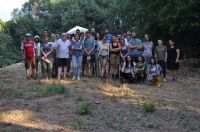
The 2021 teamAfter an interruption in 2020 due to the Covid-19 sanitary crisis, a new excavation campaign was conducted at Dikili Tash during the Summer 2021 (6 weeks, in July-August). Works concerned the same two areas that had been explored in 2019: sector 7, at the top of the tell, where we continued the investigation of Bronze Age levels, and sector 9, on the Northern slope, where we intend to expose a full Neolithic sequence. The team included 35 persons in total, archaeologists, students and workmen, coming from Greece, France and Bulgaria. Preliminary reports should soon be published in the Chronique des fouilles en ligne, the Bulletin Archéologique des Écoles françaises à l’étranger, the Ergon and the Praktika of the Archaeological Society at Athens.
Dikili Tash awarded with the 2020 Great Prize of Archaeology of the Simone & Cino Del Duca Foundation – Institute of France
Published on : 16.06.2020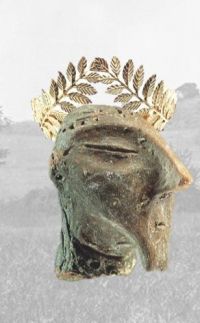
Dikili Tash laureate!!!On May 26th, 2020, the Institute of France (institution from which stem all the Academies in France) announced the list of laureates for the various prizes it distributes every year — in sciences, arts, social action, etc. The prestigious Great Prize of Archaeology of the Simone & Cino Del Duca Foundation goes this year to the Greek-French archaeological mission of Dikili Tash. The committee who took the decision, composed by members of the French Academy of Inscriptions and Letters, says recognizing in this way “the record of the work already fulfilled in this mainly protohistoric settlement and the quality of the projects for the forthcoming years”.
This prize, which arrives on the very year of the centenary from the first archaeological research at Dikili Tash, should help us realize indeed our excavation projects in the frame of the new cycle started in 2019 and also achieve a better valorisation of the site, on the spot as well as virtually.
See the page : Great Prizes of the Foundations
Last volume of publication of Jean Deshayes’ excavations
Published on : 16.06.2020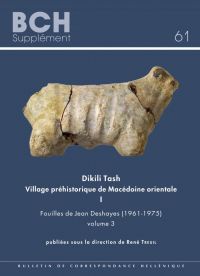
The publication of Jean Deshayes’ excavations at Dikili Tash (1961-1975) under the direction of René Treuil is now completed, with the release of the third and last part as a supplementary volume to the Bulletin de Correspondance Hellénique (BCH Supplément 61, 2019). The volume contains two major chapters: one about the EBA and LBA pottery, by Dimitra Malamidou, and one about clay figurines and models, by Christina Marangou. D. Malamidou and R. Treuil summarize at the end the main outcomes of Jean Deshayes’ investigations and connect them with the general evolution of research at Dikili Tash. Illustration includes 76 plates with drawings and 22 plates with photographs, 7 of which in colour.
See the page : e-publication
Start of a new (4th) cycle of research in 2019 – the first excavation campaign
Published on : 08.06.2020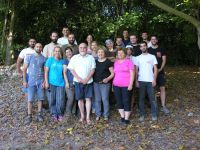
The 2019 team2019 saw the start of a new cycle of excavations at Dikili Tash that should extend at least until 2023. The directors and the institutions involved in this new research program are the same as those of the previous one. The new works focus on two axes: a) the investigation of the Late Bronze Age settlement remains at the top of the tell and the exploration of the underlying layers, in search of evidence about the missing Middle Bronze Age; b) the investigation of the Neolithic sequence preserved at the Northern slope of the tell, with emphasis on the earlier phases (prior to 5400 BC) down to the very first occupation level, dated to the mid-7th millennium.
The first field campaign was carried from July 1st to August 9th, 2019, and involved ca. 20 people. In sector 7, at the top of the tell, excavation revealed part of the fallen superstructure and the floor of a LBA building whose length should be at least 15 m; unfortunately the outer walls are lost due to later disturbances (Byzantine and Ottoman period) and previous excavations. A new sector 9 (13 x 13 m) was installed at the Northern slope of the tell, around the point of the core drilling C3 of 2010. The campaign was spent on clearing of the area from vegetation and removal of the upper colluvial layers; among the finds collected (mixed material of LNII, BA, and Historical periods) is a double-headed animal figurine of LN II date, practically identical to the one found inside the oven of House 1.
Building with earth in the Neolithic period
Published on : 27.05.2020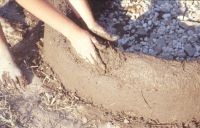
Experimental building of an ovenIn a paper published in the Bulletin de Correspondance Hellénique 143.1 (2019), p. 1-61, Sandra Prévost-Dermarkar presents in detail the morpho-technological approach used for the study of earthen architectural remains during the second research program at Dikili Tash (1986-2000). Thanks to the systematic use of experimental archaeology, it was possible to produce a reference collection for the various materials and gestures, and validate a series of hypotheses. The results obtained confirm the preferential use of husks as vegetal temper in the construction earth, and highlight the use of a frame of joint posts for the building of house walls as well as that of stacked coils for the building of oven vaults. The paper is accompanied by a glossary of technical terms in three languages: French, English and Greek.
See the page : e-publication
Synthetic volume with the results of the 2nd and 3rd research program
Published on : 27.05.2020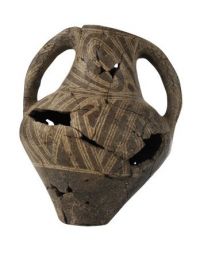
Graphite-painted amphora (Late Neolithic II, ca. 4300 BC)In June 2018, our team submitted for publication to the Archaeological Society at Athens and the French School at Athens the “manuscript” of a 700-pages-volume presenting the results from the second (1986-2000) and the third (2008-2016) Dikili Tash research program as regards the evolution and history of the settlement. The volume contains information about excavation strategy and methods, followed by a detailed presentation of the results from sectors 1 to 7, concerning stratigraphy and sedimentation, buildings’ layout, association of artefacts, subsistence remains, and chronology. In separate chapters are discussed data from cores and evidence about paleoenvironment, as well as absolute chronology as a whole, based on the 136 measurements available so far on the site (all programs). The book is in French, with extended summaries in English and Greek.
The publication, which is currently at the final stage of editing procedure, has received funding from the Institute for Aegean Prehistory (INSTAP) and the company Raycap (Greek branch, Drama).
A new phase of occupation at Dikili Tash: the Final Neolithic/Final Chalcolithic (end of 5th–beginning of 4th millennium BC)
Published on : 25.05.2020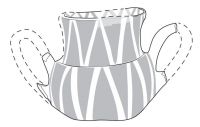
Graphite-painted cup (Final Neolithic/Final Chalcolithic, ca. 4000 BC)In a paper published in the Bulletin de Correspondance Hellénique 139-140.2 (2016), Zoï Tsirtsoni and Dimitra Malamidou present in detail the excavation context, pottery and first 14C dates from a level discovered in 2013 in the northwestern part of sector 6, establishing a new phase of occupation at Dikili Tash dated to the Final Neolithic/Final Chalcolithic period. According to 14C dates, it should be placed at about 4000 BC. Some 80 ceramic vessels and fragments have been collected that find parallels in the material from coeval sites in the neighbouring Rhodopes and Thasos. It is the first time that this phase is attested on a tell settlement in the area, thus inviting us to revise the scenario of an abandonment of lowland sites towards 4200 BC. Moreover, the early presence of some pottery features typical of the Early Bronze Age invites us to reconsider some aspects of the emergence of this period.
See the page : Read the paper
The gold of Dikili Tash at the French Academy of Inscriptions and Literature (20/10/2017)
Published on : 10.10.2017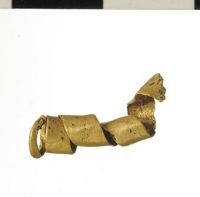
Twisted gold sheet from house 1 (4300-4200 BC)On October 20th 2017, Zoï Tsirtsoni is giving a public lecture at the French Academy of Inscriptions and Literature (Académie des Inscriptions et Belles-Lettres) in Paris, under the title: “Gold and its uses in the region of Philippi during the 5th millennium BC”. She will present several Late Neolithic II items recently discovered at Dikili Tash that are either made of gold (ornaments) or decorated with gold-paint (ceramic vessels). Such items are extremely rare in settlements of this period, not only in Greece but in the entire Balkan peninsula. Many elements suggest that these objects are locally made, which would be indeed compatible with the geology of the area, famous in Antiquity for its gold resources. The Neolithic finds from Dikili Tash would thus attest for a very early exploitation of the precious metal.
See the page : See the program and the abstract
Arthur Glais, Societies-Environment Interactions in Eastern Macedonia (Northern Greece) since the beginning of the Holocene
Published on : 16.06.2017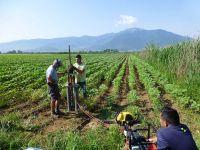
Core-drilling in the surroundings of Dikili TashOn May 19th, 2017, Arthur Glais has publicly defended his PhD thesis on Geography at the University of Caen Normandy, entitled: Societies-Environment Interactions in Eastern Macedonia (Northern Greece) since the beginning of the Holocene: a multi-scalar and palaeoenvironmental approach. The research carried out in the frame of this PhD, under the direction of Laurent Lespez and José-Antonio López-Sáez, allows reconstructing the socio-environmental dynamics in the Lower Strymon Valley and in the Drama-Philippi plan, especially around the site of Dikili Tash.
Lecture at the National Library of France (19/04/2017)
Published on : 01.04.2017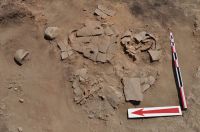
Group of vessels during the 2012 excavationOn April 19th, 2017, Pascal Darcque is giving a lecture at the National Library of France about the recent research at Dikili Tash, in the frame of a cycle of lectures entitled “Archaeology in Greece: from the excavation to the writing of history”. The investigations allowed establishing the date of the earliest settlement in the years around 6400 BC, corresponding to the beginning of the Neolithic period in this area. Moreover, several quite well-preserved houses offer insights to the Neolithic way of life for the years between 5000 and 4300 BC, and reveal some original agricultural and craft-making practices.
See the page : See the program
The activities of the years 2015–2016
Published on : 12.10.2016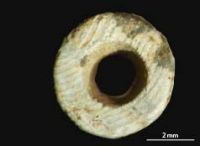
The years 2015 and 2016 were dedicated to the study of finds, laboratory analyses and preparation of publications. Here are some of the most remarkable results of these two years’ works:
Among the numerous architectural fragments retrieved from the 2013 excavations in House 1, we have identified pieces from a platform that was probably in connection with one of the ovens, as well as some possible roof fragments.
The study of ceramic material from the level excavated the same year in the NW part of sector 6, at an intermediary position between the destruction of House 1 (LN II period) and the earliest EBA features, confirms that this should be assigned indeed to the Final Neolithic period (also called Final Chalcolithic). The best parallels are found among the material from sites in the neighbouring Rhodope mountains (Yagodina, Tatul, Dolno Dryanovo, Ilinden); C14 dates from both Dikili Tash and those sites fall in the years around 4200-3900 cal BC. We should add then sector 6 in the parts of the tell where occupation continued after 4300 BC.
Study under a high-resolution microscope allowed establishing that only 40 out of ca. 1300 Neolithic beads known from the site are made from shell; the others are made of stone. This identification method is more immediate than the infrared spectroscopy previously used to distinguish between the two materials.
We also pursued our efforts for integrating the results from all works conducted so far on the site into a unique relational database: the database contains at present no less than 4.550 entries for stratigraphic units and 42.425 entries for objects.
Philippi on the World Heritage List
Published on : 12.10.2016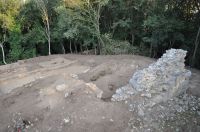
The archaeological site of Philippi has been inscribed on UNESCO’s World Heritage List in July 15th, 2016, during the organization’s 40th annual session held in Istanbul. Philippi becomes thus the 18th Greek site inscribed on this prestigious list, next to the Acropolis of Athens, Delphi, Olympia, Vergina, or Meteora. Although Dikili Tash is not directly concerned by this decision, it will certainly be touched by the inscription’s positive impact on the area.
See the page : UNESCO website
They were drinking red wine at Dikili Tash in 4300 BC
Published on : 12.10.2016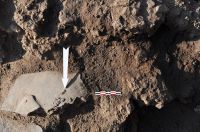
Nicolas Garnier and Soultana Maria Valamoti present, in an article published in the Journal of Archaeological Science (first release on-line in May 2016), a new analytical protocol that allowed identification of red wine on the walls of a big ceramic jar and a small jug discovered in House 1, destroyed by fire towards 4300 cal BC. The results of chemical analysis add themselves to the evidence from archaeobotanical remains (grape pips and skins) found in association with the jar. This is so far the earliest testimony of wine-making in Eastern Mediterranean and Europe.
It should be reminded that part of this research was funded by the National Geographic Society, who greeted the publication of the scientific results with a small article in its blog. The results have further been echoed in the specialized press.
See the page : Article of the Journal of Archaeological Science
PLANTCULT, a European project
Published on : 12.10.2016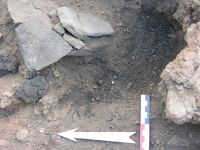
Our specialist in archaeobotany Tania Valamoti, professor at the University of Thessaloniki, received in December 2015 a Consolidator Grant by the European Research Council for her project “Identifying the food cultures of ancient Europe: an interdisciplinary investigation of plant ingredients, culinary transformation and evolution through time”. The project, which brings together some 35 specialists and PhD students from a dozen of countries, will run in the years 2016–2021. Its aim is to explore culinary practices among early farming European communities, from the Aegean to Central Europe and from the Neolithic to the Iron Age (7th–1st millennia BC). Hara Procopiou and Zoï Tsirtsoni participate in it as specialists of grinding tools and ceramic vessels respectively. Dikili Tash is one of the project’s key-sites.
See the page : CORDIS - ERC
Pollen studies confirm that agro-pastoral activities around Dikili Tash started towards 6400 BC
Published on : 12.10.2016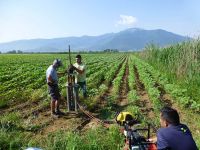
Arthur Glais, José Antonio Lopez Saez, Laurent Lespez and Robert Davidson published in Quarternary International (first release on-line September 2015) the results of their latest research on the landscape around Dikili Tash and the relationship with human activities, especially at the beginning of the Neolithic period. Two new pollen records from cores located respectively 1.75km and 150m from the archaeological site provide the first evidence of agro-pastoral activities since ca. 6400 cal BC. These activities are undoubtedly connected with the installation of the earliest Neolithic communities on the site. The results thus agree with those retrieved from intra-site cores a few years ago.
See the page : Article of Quarternary International
4.10.2014 - “The primal greece : between dream and archaeology”. Exhibition at the national archaeological museum of Saint-Germain-en-Laye (Paris)
Several members of the Dikili Tash team participated at the preparation of a big exhibition on the discovery and reception of the Aegean prehistory in France, which opens its doors in Paris (National Archaeological Museum of Saint-Germain-en-Laye) on the 5th of October. Based on an idea of Anaïs Boucher, who is also the general curator, the exhibition traces the history of the first discoveries of prehistoric objects and sites in Greece and its neighbouring areas (Troad, Bulgarian Thrace) made by French scholars (like F. Fouqué, or Gorceix and Mamet at Santorini), or made by others but further diffused in Europe through the action of major French institutions, starting by the Museum of Saint-Germain-en-Laye itself. The exhibition discusses also the impact of these discoveries on the art of the early 20th century (sculpture, theatre, fashion), as well as on lifestyle (travels, for example), and which produced a true “Aegean trend” among some of the high classes. The last section focuses on the current researches in our field, showing the progress made in one century and a half. Dikili Tash is one of the projects used to illustrate this progress; we underline the pluridisciplinary character of the recent works, and the interest for the everyday life of neolithic people (house building with clay, food practices, crafts, function of spaces or objects, etc.). The exhibition ends on January 19th, 2015.
10-14.09.2014 - Papers presented at the 20th Annual Meeting of the european association of archaeologists in Istanbul
Dikili Tash was well represented at the 20th Annual Meeting of the European Association of Archaeologists (EAA), which was held in Istanbul between the 10th and 14th of September with more than 2500 participants. Two papers have been presented at two different sessions. The first one, pronounced by Laurent Lespez in a session dedicated to the spread of the Neolithic in the area between the Bosporus and the Lower Danube (co-organised by Zoï Tsirtsoni), presented the geoarchaeological works carried on the site since 2010, thanks to which we identified the earliest occupation levels. He insisted on the advantages of the method used (core drillings) by comparison to others (survey, trenches), and called for a broader use of it in other tells of the region.
The second paper was about jewellery: it was pronounced by Céline Choquenet in a session dedicated to the social complexity in the Balkans during the 5th millennium BC. Focusing on the finds from the 2012 and 2013 excavations in house 1, it discussed the question of jewellery-making from a technical point of view (raw materials, processing) as well as from a social aspect (context of production, standardisation, circulation of raw materials and objects by opposition to the circulation of concepts and techniques), integrating Dikili Tash in the broader frame of the Aegean and the Balkans.
10.09.2014 - CAMPAIGN 2014
After two consecutive years of excavation, 2014 was a year of study, conducted in the frame of several successive field campaigns between the months of May and September. Most of the works concerned the treatment of the 2012 and 2013 finds, especially pottery (refitting, restoration, recording, including drawing), architecture (sorting of fragments, recording), ornaments (recording, further sampling for analyses) and botanical remains (water-sieving of the last sediments collected on the field, sorting, study of the charred grains and charcoals). In addition, we proceeded to a new series of core drillings in the tell’s surroundings, in order to complete the file about the palaeoenvironment and establish more precisely the extent of the original settlement.
Parallel to that, we advanced in another long-term project: the unification of the databases of all three research programs conducted so far at Dikili Tash. The new integrated database will be hosted on the server of the French School at Athens and will be accessible through Internet. It is completed by an interface for the spatial representation of finds and units (GIS), developed by Vincent Depond, one of the trainees-topographers of the 2013 team. Access to these tools will be provided, first, to the collaborators of the Dikili Tash project, but in the future some parts could also be open to a larger public.
1-7.09.2014 - Paper presented at the XVIIe Congress of the International Union of Préhistoric and Protohistoric sciences (UISPP), at Burgos
Arthur Glais represented Dikili Tash at the XVIIe Congress of the International Union of Prehistoric and Protohistoric Sciences (UISPP), which was held at Burgos (Spain) between the 1st and the 7th of September. His paper, presented at a session about climate changes and their relation with human evolution in the Mesolithic and Neolithic period, provided an up-to-date synthesis of the environmental data from Dikili Tash, integrating also the results from his latest palynological analysis of the 2012 and 2013 core samples.
13-15.3.2014 - Paper presented at the 27th Annual Meeting of Archaeologists working in Macedonia and Thrace (AEMth)
Zoï Tsirtsoni presented the results of the 2013 excavations at the 27th Annual Meeting about the Archaeological works in Macedonia and Thrace (AEMTh), held at Thessaloniki between the 13th and 15th of March. She discussed the recent finds from the northern part of house 1, after removal of the last fallen wall fragments: remains of a new domestic oven (suggesting that the house was probably composed by two rooms), next to it a jar full of charred grape-pips, and further to the south a group of ceramic vessels on the floor containing colouring materials and tools. All these elements confirm the impression that we got already from previous years (especially 2012): that house 1 is a place where activities of different nature took place. This evidence makes us think about what is an “ordinary” Neolithic house.
The other important discovery of the 2013 campaign was the revealing of an occupation layer rich in mobile finds, that postdates the destruction of house 1 and yet is earlier than the first Bronze Age structures. It is the first time that such a transitional level is found not only at Dikili Tash, but more generally in a Northern Greek tell settlement. This discovery renews the discussion about the end of the Neolithic period in the area, and puts the bases for a better understanding of the relation between the latter and the following Early Bronze.
15.12.2013 - First Prize Clio 2013 to the Dikili Tash research program
The French society Clio, specialized in cultural travels, has attributed this year the first prize for the encouragement of French archaeological activity abroad to the Dikili Tash research program (see http://www.clio.fr/prixclio/). Clio prizes are attributed every year upon recommendation of an independent committee composed by renowned French scholars. The official presentation will take place in Paris on February 11th, 2014.
10.10.2013 - reminder: applications for participants at the grundtvig (EU) training course at dikili tash
This EU-funded training course/seminar is addressed to citizens from EU countries involved in adult education and training : see below, announcement of 21.05.2013. The course will take place between the 23th and 28th of June 2014. Appications should be send before the 16th of January 2014 to the Agency for Lifelong Learning programmes of the candidates’ country (see list in http://ec.europa.eu/education/lifelong-learning-programme/national_en.htm).
21.9.2013 - documentary on Dikili Tash presented at the museum of Saint-Germain-en-Laye in Paris
The Canadian film-director Julie Perron presented in a public session organised by the district council of Yvelines at the Archaeological Museum of Saint-Germain-en-Laye (Paris) a 15 min documentary about Dikili Tash, entitled “Leaving with the Earth”. The film, assembled from scenes shot during the 2012 field campaign, focuses on the archaeobotanical researches carried on at the site, putting forward their significance for our overall understanding of the relation between humans and Nature. The director has discussed the possibility to make similar films for other categories of works among those she filmed at Dikili Tash.
18-28.9.2013 - French school Seminar for post-graduate Students at Dikili tash
G. Kourtessi-Philippakis and R. Christidou, both members of the Dikili Tash team, organised a seminar for post-graduate students about the bone and chipped stone industries in Neolithic Northern Greece. Part of the program took place at Dikili Tash itself, with the participation of D. Malamidou. This seminar entered in the annual cycle of seminars of the French School at Athens. and was attended by a dozen of students coming mostly from Greek and French universities, but also from third countries. In addition to theoretical courses, the students had the possibility to manipulate the original artefacts and discuss with the trainers the various technical aspects of their study.
20.8.2013 - Field campaign 2013
Fieldwork was carried on from the 1st of July to the 10th of August and involved some 40 persons, archaeologists, specialists from other fields (geology, physics, etc.), technicians, and local workmen. Like in 2012, we concentrated our efforts on sector 6, where we continued the excavation of House 1, destroyed by fire in the years around 4200 BC (Late Neolithic II period). The quantity and quality of the unearthed archaeological material is once again remarkable. Several analytical works are already engaged in order to explore further these rich assemblages.
17-22.6.2013 -Paper presented at the 16th International work group for palaeoethnobotany (IWGP) at thessaloniki
T. Valamoti organised the 16th International Work Group for Palaeoethnobotany (IWGP), which brought together for 4 days at Thessaloniki more than 250 specialists. Her own oral presentation, entitled “Harvests from beyond the fields: on acorns, wild pears and grapes from Neolithic Dikili Tash, Northern Greece”, was dedicated to the results of the recent researches on the botanical remains from House 1 at Dikili Tash. She insisted on the coexistence under the same roof and the similar management of botanical species that are properly cultivated (e.g. cereals), and others that are simply collected. These results invite us to think further upon the distinction between “wild” and “domesticated” plants, and provide a lot of useful clues for the understanding of Neolithic economies.
7-9.6.2013 - Paper presented at the athens International Conference on the aegean Neolithic
The Dikili Tash team presented a paper at the International conference Communities in transition: the circum-Aegean Later Neolithic stages (c. 5000/4800-3200/3000 BCE), organised in Athens by the Danish Institute and the Greek Ephorate of Speleology and Palaeoanthropology. The paper was entitled “The chronological and social dimensions of the Late Neolithic I-II and the Late Neolithic-Early Bronze Age transitions in a long-living settlement in Northern Greece (Dikili Tash, Kavala district)” and discussed the questions of continuity and discontinuity between the two. We insisted on the possibility that offers a site like Dikili Tash to proceed to such comparisons, thanks not only to the overall duration of occupation but also to the extent of the carried research.
21.5.2013 - EU-funded seminar at Dikili Tash: new date in June 2014
The Dikili Tash team participates at the organisation of a 6-days training course/seminar funded by the European Commission in the frame of the Grundtvig Programme for Lifelong Learning, and coordinated by the Environmental Educational Centre of Philippi. Announced originally for June 2013, this training course, which is addressed to EU-citizens involved in adult education and training (museum conservators, tutors, etc.), is now scheduled for the period from 23 to 28 June 2014. It discusses the conditions of human settlement in the broader area of Philippi-Kavala, insisting on the relations with the natural environment and on the lessons from past history for today’s societies, especially as far as it concerns sustainable development. In addition to lectures, the participants will have the occasion to assist on fieldwork, develop their skills through experimenting with ancient materials, and elaborate their own ‘tools’ later allowing to transmit the acquired knowledge to other adults. All expenses are covered by the EU. A detailed description is found in
http://ec.europa.eu/education/trainingdatabase/index.cfm?fuseaction=DisplayCourse&cid=34531
For further information and submission of applications, contact the national Agency for Lifelong Learning programmes in your EU member country (see list in http://ec.europa.eu/education/lifelong-learning-programme/national_en.htm).The deadline for applications is the 16th of January 2014.
22-26.4.2013 - Paper presented at the international symposium of archeometry at caen (normandy)
S. Prévost-Dermarkar and C. Germain-Vallée presented a poster at the XIXth Symposium of the GMPCA (French Association of Archeometry), held at Caen (Normandy), about the technique of house-wall construction with a clay mixture on joined posts. This technique, which is much used at Dikili Tash in the Neolithic, was first studied in the late 1990s by S. Martinez based on evidence from sector V. By combining a morphological and technological examination, with micromorphological analysis, ethnographical observations and experiments, the authors come up with a reconstruction of the whole preparation and building process (chaîne opératoire)
20-22.3.2013 - Paper presented at the 26th Annual Meeting of Archaeologists working in Macedonia and Thrace (AEMth)
D. Malamidou presented at the 26th Annual Meeting about the Archaeological works in Macedonia and Thrace, in Thessaloniki, the results of the 2012 field campaign at Dikili Tash. Her presentation, entitled “Snapshots from the life of a Neolithic household: the House 1 at Dikili Tash”, focused on the significance of some of the assemblages revealed in 2012 (various types of vessels, sometimes preserving their content, ornaments found together with raw materials, etc.: photos). Such associations suggest that the division between living- or working-spaces, on one hand, and spaces for storage or cooking, on the other hand, might be inappropriate for this kind of society.
19.3.2013 - Release of the article about the 2010 corings in Antiquity
An article just came out in the Antiquity journal (vol. 87, n° 335) presenting the results of the corings conducted at the tell of Dikili Tash in 2010 (sedimentogical study, radiocarbon dates, artefacts). It is the first time that in situ levels of the second half of the 7th millennium BC (ca. 6400 BC) are discovered in the plain of Drama : see below, the announcement dating 05.05.2011.This discovery definitely closes the discussion about the presumed delayed start of the sedentary way of life in Greek Eastern Macedonia and puts on a new basis the debate upon the “neolithisation” of South-East Europe.
19.1.2013 - Conference at the french academy of inscriptions and letters in paris
Pascal Darcque pronounced a conference about the recent researches at Dikili Tash at the French Academy of Inscriptions and Letters in Paris. Several academicians expressed their interest about the latest discoveries on the settlement’s start in the Early Neolithic period and their wish to see soon these early levels properly explored by excavation.
11-14.12.2012 - Paper presented at the International Aegean Conference “Physis” (Aegeaum 14) in Paris
The Dikili Tash team presents a paper in the 14th International Aegean Conference (Aegeaum 14 : Physis) held in Paris between the 11 and 14 December 2012, entitled “The impact of environmental changes on the Neolithic settlement of Dikili Tash”. Are discussed the relations between humans and natural environment, as one can trace them through the study of two key-moments in the settlement’s history: the first human occupation in the Early Neolithic and the abandonment of the site at the end of Late Neolithic.
30.11.2012 - EU-funded seminar at Dikili Tash in June 2013: call for participants
The Dikili Tash team participates at the organisation of a 6-days training course/seminar (24 to 29 June, 2013) funded by the European Commission in the frame of the Grundtvig Programme for Lifelong Learning, and coordinated by the Environmental Educational Centre of Philippi. The course is addressed to persons from all EU countries that are involved in adult education and training. It presents the main aspects of human settlement in the broader area of Philippi-Kavala, insisting on the relations with the natural environment, on the prehistoric building and manufacturing techniques, and on the lessons from past history for today’s societies, especially as far as it concerns sustainable development. In addition to lectures, the participants will have the occasion to assist at the excavation, develop their skills through experimenting with ancient materials, and elaborate their own ‘tools’ later allowing to transmit the acquired knowledge to other adults. All expenses are covered by the EU. A detailed description is found on line. For further information and submission of applications, you should contact the national Agency for Lifelong Learning programmes in your EU member country (see list in http://ec.europa.eu/education/lifelong-learning-programme/national_en.htm).The deadline for applications is the 16th of January 2013.
22-24.11.2012 - International Conference about one century of research in prehistoric Macedonia
René Treuil was invited to present an overview of the researches carried so far at Dikili Tash at the International Conference “1912-2012. A century of research in prehistoric Macedonia”, which was hold at Thessaloniki, from 22 to 24 November 2012. In his speech, entitled “One century of research at Dikili Tash”, he insisted on evolutions in the approach adopted by the successive teams of archaeologists working in the field: clearly cultural-historical in the early years, it became more and more anthropological over time, focusing on humans rather than abstract ‘cultural’ entities.
30.08.2012 - 2012 Summer excavation campaign
The 2012 excavation campaign was carried out from July, 2 to August, 10. Some forty persons participated to it, coming from Greek and French institutions (Universities, especially the Aristote University of Thessaloniki, CNRS, French Ministry of Culture, EFA). Fieldwork concentrated on sector 6, where was continued the excavation of House 1 (Late Neolithic II), and of the Early Bronze Age remains lying on top of it. The finds from House 1 are exceptional in wealth and preservation, and confirm the variety of activities that took place inside the building. Among them, we should mention storage, of both solid (grains, fruits) and liquid foodstuff, sometimes hold in specifically designed containers. We also established craft-working, namely manufacture of ornaments from various raw materials (clay, shell, bone, stone, metal). Future analyses should allow investigating the multiple aspects of these finds (provenance, technology, role in the household).
We also made four new core drillings on the tell. The study of the extracted sediments and associated artefacts seems to confirm the results of the 2010 cores, especially concerning the start of the occupation at the settlement. Additional C14 datings should allow establishing the extent of this first village.
3.02.2012 - Applications for participants in the 2012 Summer field campaign
The 2012 field campaign is scheduled from July 2nd to August 10th. Students in archaeology or other related fields who are interested in participating in the campaign are invited to send their applications by e-mail to P. Darcque or Z. Tsirtsoni before the end of March, accompanied by a short curriculum vitae. French or Greek language skills are appreciated but not necessary. Applicants should expect to receive an answer by the end of April, together with details about their tasks, venue, and accommodation.
3.02.2012 - Applications for participants in the 2012 Spring pottery study campaign
A campaign is scheduled between the 18th and 28th of April; we will focus on searching for pottery fragments that refit. Students in archaeology or restoration who are interested in participating are invited to send their applications by e-mail to Z. Tsirtsoni before March 10th, accompanied by a short curriculum vitae. Applicants will receive an answer during the month of March.
03.02.2012- English version on-line
We welcome the new year with the opening of the website’s English edition, together with a few improvements in the other editions.
17-19.11.2011 - Paper presented at the International Symposium about Olive-oil and Wine production in Eastern Mediterranean during Antiquity, at Izmir
T. Valamoti presented (in collaboration with P. Darcque, Ch. Koukouli-Chryssanthaki, D. Malamidou and Z. Tsirtsoni) a paper entitled “An archaeobotanical investigation of prehistoric grape vine exploitation and wine making in the Aegean: recent finds from Dikili Tash”, at the International Symposium about Olive-oil and Wine production in Eastern Mediterranean during Antiquity, held at Izmir (Turkey) between November 17th-19th. She discussed the recent discoveries from House 1 (sector 6, Late Neolithic II period), as well as those from the Late Bronze levels, placing them within their historic and regional context.
21.10.2011 - Opening of the Dikili Tash website
The new Dikili Tash website opened to the public (in French and Greek versions only) as a way to celebrate the 50 years from the start of the first systematic excavations at the settlement, in July 1961, under the auspices of the Archaeological Society at Athens and the French School at Athens. The English version will be open soon.
20.08.2011 - Study campaign 2011
The annual summer study campaign took place between July 4th and August 20th 2011. Participants included more than 20 Greek and French specialists and technicians from various disciplines (archaeologists, geomorphologists, topographers, artists), as well as a dozen students (BA, MA, PhD) and young scholars (post-doc), mostly Greeks (University of Thessaloniki) but also some coming from the University of Poznan (Poland). Work focused on the earliest settlement and the evolution of the tell, and on the collection and study of archaeobotanical remains.
05.05.2011 - The earliest occupation layers at Dikili Tash
n 2010, we made a new series of drillings in the tell down to natural soil and collected several samples for C14-dating. The results confirm that the site was settled for the first time in the second half of the 7th millennium BC, i.e., roughly the same time that the first Early Neolithic settlements appear in Western Macedonia (Nea Nikomedeia) and Thessaly (Achilleion, Sesklo). The occupation continues uninterrupted into the Middle and Late Neolithic (which was already known from excavations), thus providing a sequence that covers the whole 6th millennium BC. These discoveries fill a serious gap in the map of prehistoric settlements in Eastern Macedonia.
12.03.2011 - Paper presented at the annual Meeting of archaeologists at Thessaloniki
P. Darcque, Ch. Koukouli-Chrysanthaki, D. Malamidou, Z. Tsirtsoni and T. Valamoti communicated the results of the 2010 excavations at Dikili Tash, in the 24th Annual Meeting about the Archaeological Activities in Macedonia and Thrace (AEMTh), held at Thessaloniki (March, 10-12).

